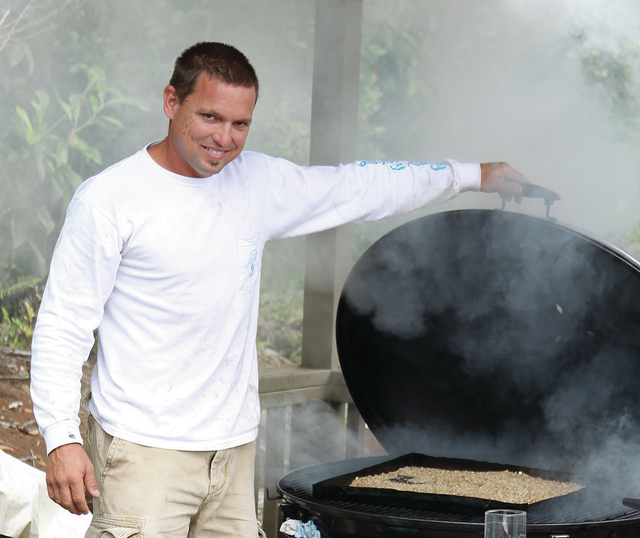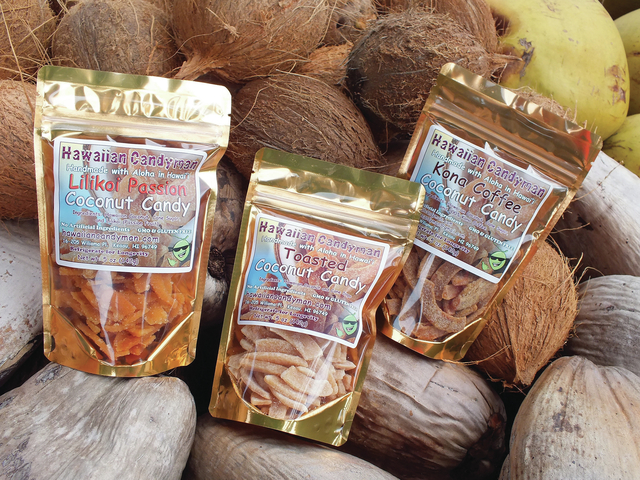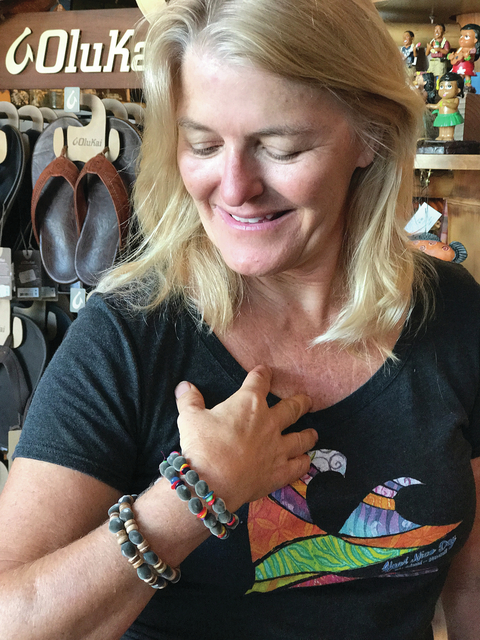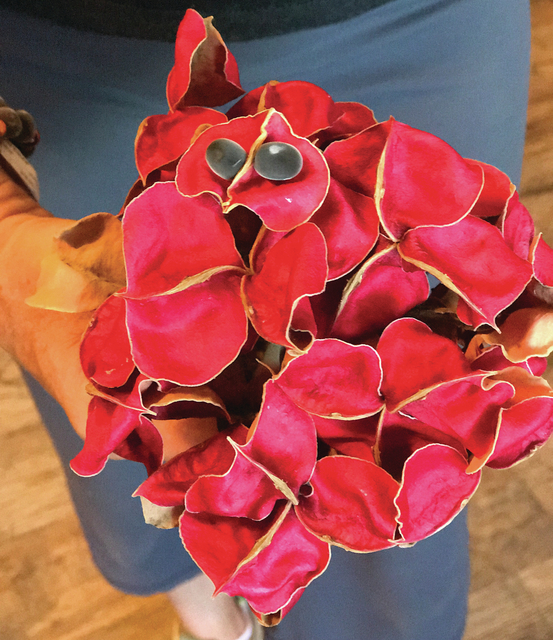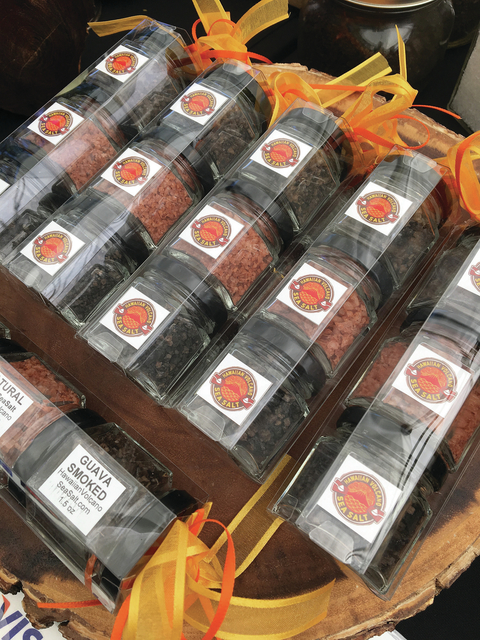Made in North Hawaii
NORTH HAWAII — With the holiday season upon us, so too is the shopping dilemma. It’s difficult sometimes to find just the right gift — that’s affordable too — for that auntie or uncle who has everything.
North Hawaii is fortunate to have many artisans who are devoted to their craft, be it food creations or unique handmade items often with a tropical twist. In a two-part series beginning today, the North Hawaii News elves have researched some readily available options made by local purveyors with a story of their own.
A salty sensation
Hawaiian Volcano Sea Salt not only tastes good but is actually good for you, too. Tests show salt taken from the pure deep water has 48 percent less sodium than table salt, and more trace minerals including calcium, potassium and magnesium.
Purveyors Sam and Paige Wilburn begin their product process with salt harvested from the ocean at 2,200 feet deep. The salt is air- and sun-evaporated on screens in Kailua-Kona greenhouses before the final step: cold smoking over woods gathered from around the island.
Sam says he is one of very few who actually smokes his salt with real, local woods.
“We don’t add seasoning for flavor, nor do we roll the salt in activated charcoal for color,” he said. “We truly smoke the salt over a fire for a product that’s a 100 percent natural way to add a roasted or grilled flavor to food.”
Architects by trade, the Wilburns live outside Honokaa. They moved to the Big Island just shy of a decade ago from Austin, Texas, where they, like most Texans, were backyard grill masters.
“In Texas — much like Hawaii sans the beach — grilling and barbecue is in most backyards, bringing friends, family and neighbors together at celebrations and weekends,” Sam said.
The inspiration for Hawaiian Volcano Sea Salt came when, shortly after coming to Hawaii, Sam ran out of one of his grilling essentials — smoked salt.
“I looked all over the island and asked friends, but no one had a clue what I was talking about,” he remembered, so he decided to try making it himself.
After sourcing the salt, he began hundreds of hours perfecting his product.
Sam smokes the salt using wood gathered from trees cut for prescribed firebreaks or from naturally fallen trees. Two Hawaiian woods in particular — guava and kiawe — make up the exotic flavor profile of Hawaiian Volcano Sea Salt.
A fruiting tree, guava produces a smoked salt that has a light earthy sweetness in its aroma and flavor. The slow smoke process changes the white flaky salt crystals to a toasty caramel brown color. Sam recommends trying it with seafood, poultry and steamed vegetables or using it as a rub or a smoky brine.
The kiawe tree is a dense wood that gives the salt a bold and rich smoky flavor. The salt is transformed into a very dark iridescent ebony color that goes great on red meat, pork chops and hearty vegetables and in creamy soups and pasta.
The Wilburns sell their salt at the Waimea Town Market on Saturdays, Wednesdays at the King’s Shops Farmer’s Market in Waikoloa, and the first Sunday of the month at the Kona Stroll. Prices start at $15.
The candyman can
The owner of Hawaiian Candyman, David Lee Roth, has been obsessed with coconuts for as long as he can remember.
“I look at coconuts and think they’re the greatest thing ever,” he said.
He remembers opening the first one when he was just 4 years old.
“I took a screwdriver and my plastic powder-blue hammer and whacked at it until I got it,” he laughed.
More than 30 years later, the native Floridian is still whacking coconuts, only now he’s doing it on the Big Island as fodder for his business. He currently sells his dried coconut candy at the Waimea Town Market at Parker School on Saturdays, where it’s a big hit, especially for tourists who have heard about coconut candy in Hawaii and are looking for it.
“When they find me they’re always very excited,” Roth said.
After years of researching coconuts and perfecting his production process, the Hawaiian Candyman’s dried coconut candy is fresh and contains very little sugar.
“It’s really about the great natural taste of the coconut,” Roth said. “I don’t want it to be overly sweet.”
The process begins with Roth collecting the coconuts in Kapoho. They are everywhere, but he takes only the mature ones, as they are perfect for candy. He then husks, shells, peels and slices the coconuts. Next comes dehydration and the actual candy-making process, which in its entirety can take a backbreaking five to six hours a day, four to five days a week.
Roth agrees it’s a lot of work but he doesn’t mind.
“I love what I do,” he said. “It’s all about taking pride in your product.”
He also takes the time to infuse different flavors into the coconut, with more than a dozen flavors. Classic toasted coconut and lilikoi are the most popular, followed by ginger, and coffee coconut which he makes using 100 percent Kona coffee sold by one of his farmer’s market neighbors.
The candy is sold in five-ounce resealable plastic bags and considering what it takes to make, is a steal at $9 a bag.
Jewelry fit for a hula dancer
Lisa Ebrahimi was first fascinated by adornage worn by hula dancers she saw while attending the Merry Monarch Festival in 2005. In particular, she loved the necklaces and bracelets made out of Hawaiian pussy willows.
She later learned Hawaiian pussy willows are in fact the dark gray velvety seeds of the mgambo tree, native to East Africa. Locally, the tree is referred to as weleweka, also known as the black pearl tree, the velvet-seed tree and the Maui mink tree. The first mgambo is thought to have arrived in the islands from Sri Lanka in the early 1960s.
By chance, Ebrahimi saw a mgambo tree at a plant sale in Waimea in 2010. She bought it, planted it and was in awe when it began producing.
“The seedpods are really beautiful,” she said.
The flowers develop into capsules that split open to reveal a bright red interior containing the seeds.
Ebrahimi yearned to make the jewelry she had seen and admired on the hula dancers but it took her a couple of years to figure out how to best duplicate. She now sells her own mgambo seed jewelry in her own store, As Hawi Turns.
She dries the seeds and creates bracelets, necklaces and earrings combining dried seeds with beads made of shells, coconuts and semi-precious stones. And because she actually planted the tree, watered it, grew it and now harvests it, her mgambo jewelry is a completely sustainable gift from North Kohala. Prices start at just $16.50.
Ebrahimi also makes driftwood wreaths sold in her store that are made from wood collected on local beaches.


